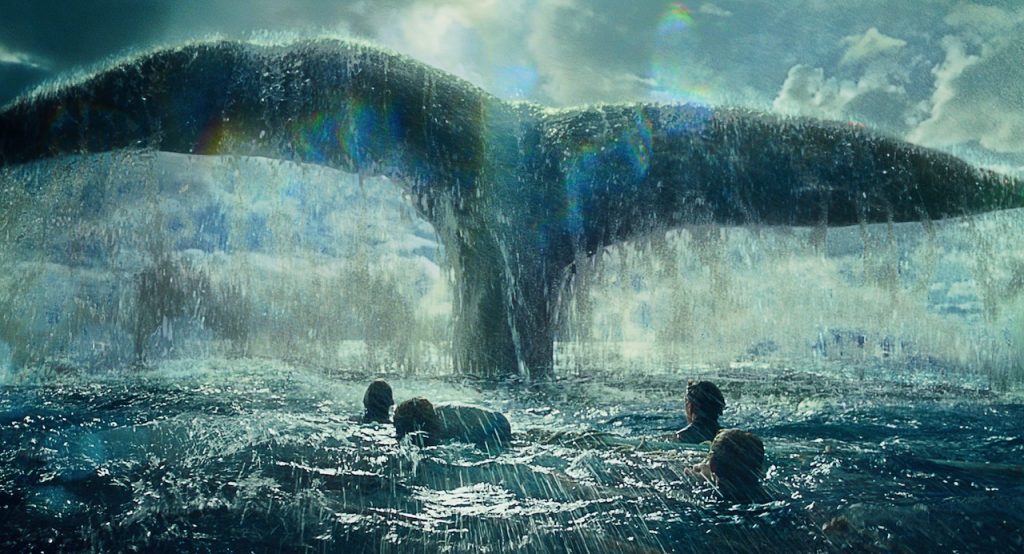Herman Melville’s Moby Dick is considered by many to be the greatest American novel of all time. Melville takes a fairly straightforward story of a captain’s quest for revenge against a great white whale, and enriches it with a plethora of symbolism and depth. The story seems larger than life and too fantastical to be true, which makes the fact that Melville based his book on actual events quite surprising. Ron Howard’s In the Heart of the Sea, an adaptation of Nathaniel Philbrick’s book of the same name, tells the story of the whaleship Essex that would become the basis for Philbrick’s magnum opus.
In the Heart of the Sea is a classic example of a below average screenplay being elevated by an extremely talented director. Howard, who has proven adept at adapting true stories with Apollo 13, A Beautiful Mind, and Rush, directs a visually striking film that is undermined by a pretentious and stilted screenplay. The whale attack scenes are some of the most intense scenes of the year, but everything that comes in between falls short. The actors are game and give it their best, but they do not have much to work with.

IMDb
Leading the crew is Chris Hemsworth, who plays the first mate of the ship, Owen Chase. The dynamic between his character and the captain, portrayed by Benjamin Walker, is one of the few relationships that actually works in the film. A friendship between the criminally underused Cillian Murphy and Hemsworth also tries to anchor the film, but we never get to see the two establish any sort of real brotherhood. Captain Pollard and Chase, on the other hand, establish a mutual dislike for each other from the start of the film, and one of the highlights of the film is watching the relationship develop as their crew is tried and tested by the untamed ocean and its awe-inspiring beasts.
And the ocean and the whales are indeed awe-inspiring beasts. Howard brilliantly contrasts the smoky, dirty aerial shots of Nantucket with the vast expanse of the ocean. Where Nantucket feels industrial, the ocean feels untouched by man. Chase and crew are truly heading into a new world. Howard uses excellent camera movement to emphasize the frightening isolation of the Essex as it heads further and further away from civilization. The whale hunting sequences are both exhilarating and terrifying. The whales look extremely realistic, and Howard uses strategic camera placement to make them look as large and intimidating as possible.
The great white whale that attacks the ship essentially becomes the villain of the movie. While there is no human antagonist, the crew of the ship encounter the same whale several times (a creative liberty taken by the filmmakers), as though the whale is following them to their deaths. This tests the suspension of disbelief, but since any sequence with the whale immediately elevates the movie, it is easy to look past these stretches of imagination. The white whale is magnificent and terrifying to behold, and its attack on the ship will have every viewer on the edge of their seat.
Unfortunately, the whale scenes are the best scenes in an otherwise mediocre movie. Instead of setting the entire film in one time period, screenwriter Charles Levitt structures the films by having an 1840s Herman Melville visit a survivor of the Essex in Nantucket, and the survivor regaling Melville with his story so Melville could write Moby Dick (In reality, this never actually happened. Melville wrote his whale of a novel without ever having visited Nantucket.). This could have been a clever plot device, but the conceit never goes anywhere. Instead, it feels like the first 20 minutes of the film tread water without introducing a compelling narrative. Had Howard and Leavitt chosen to directly tell the story, the film would have felt much less bloated.
However, the structure of the screenplay is not Leavitt’s biggest sin. The dialogue is incredibly overdramatic and pretentious. Lines like “I will return as quick as a summer’s night,” “As I live and breathe, he’s mine,” and “We were headed for the edge of the sanity, like we were phantoms, aberrations,” are far too eloquent for characters who spent a life at sea to say regularly. As a result, the characters feel more like caricatures than real people. Their plight is shocking, but because the whale attack scenes happen in the middle of the film, the ending simply feels anticlimactic.
Although In The Heart of the Sea may underwhelm, there is enjoyment to be had in the film’s fantastic set-pieces. The characters are extremely one-dimensional and the dialogue is awful, but Howard’s direction works to elevate a subpar screenplay. The connections to Melville’s Moby Dick are well intentioned, but blubber should have been cut off of a bloated film.





